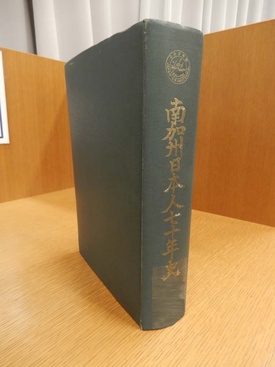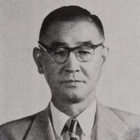"A Hundred Years of Japanese Americans in the United States" (published in December 1961), edited by Shinichi Kato, traces the footsteps of Japanese Americans in the mainland of the United States, excluding Alaska and Hawaii. Many pages are devoted to states along the Pacific coast where many Japanese emigrated and worked, with California being introduced separately into northern, central, and southern parts.
The rest are lumped together as geographical units such as the "Three Central Northern States," the "Mid-Atlantic States," and the "Southern Coast States," and are introduced by state or region within those. Looking more closely, there is no mention of "Kentucky" or "Tennessee," but it is unclear whether there were no traces of Japanese people at that point, or whether they were unable to be interviewed.
As for the rest, there is some description of them all, and many of them are specific Japanese names. Although the criteria for inclusion are unclear, personal histories are also included as a "who's who," and the number of names and related businesses listed in the index at the end of the book reaches about 1,000.
In addition to explaining the activities of Japanese people, the book also weaves in various anecdotes. How did they research and edit all of this? In such cases, it is common to look at the preface or afterword, so looking back at the book, I found that on page 1429, under the heading "Afterword, Editor: Shinichi Kato," there was a three-page description of the purpose of the publication and the process leading up to publication. The following passage caught my eye more than anything else.
Drive 40,000 miles over nine months
"With this intention in mind, for nine months, beginning in June 1960, I traveled alone, driving 40,000 miles across every state in the United States to report on my work, visiting each state as I continued editing, and gaining the sympathy and cooperation of volunteers from all over the country who said, 'Someone has to do it, and will do it for us.' I did not want to put off the centennial commemorative publication until two years later, and, as I had made it clear everywhere, I worked day and night as long as my strength allowed, with the help of the editorial staff of Shin-Nichibei-sha and the three foreign students Kawai, Kanai, and Kuwabara, so that I might complete the project by the autumn of 1961. However, as the scope of the project was so extensive, completing the monumental task of reporting, editing, and printing, which would normally take at least three years, in just a year and a half was a continuous string of day and night work that I believe I will never repeat."
It is quite an incredible feat that a book of this length and content was produced in a year and a half, from research to printing. If you look closely, you can see that there was room for improvement in the editing and design of the pages, and that there are many places where the text needs to be revised or where there are mistakes in the editing. However, even if you take that into account, it is easy to imagine that it required a considerable amount of effort.
What struck me even more as a reporter was the fact that he had driven around the vast expanse of America by himself for nine months. Even though America is a car-oriented society, it wasn't until the passage of the Federal Highway Act in 1956 that construction of interstate highways began in earnest, just four years before Kato began reporting in 1960.
Road conditions were different from today, and it would have taken nine months just to see the whole of the United States. He covered a total of 40,000 miles (about 64,000 km) while interviewing Japanese people. Crossing the United States from east to west is roughly 3,000 miles, depending on the distance between cities, so you can see how difficult it is to drive 40,000 miles.
A record of Kato's visit to Florida
However, I can't help but wonder if this is really true. Unfortunately, the details of the interview process have not been revealed. However, I did learn that Kato had indeed been running around the United States.
When I was researching the Japanese village (Yamato Colony) that was established in South Florida in the early 20th century, I came across the name of Shinichi Kato while reading and sorting through the huge number of letters sent by Morikami Sukeji, a man who stayed in the area after the colony was dissolved before the war and eventually became famous for donating a vast amount of land to the local area, to his relatives in Japan.
In a letter to his niece dated February 23, 1961, he wrote the following:
"... I received an unexpected visit from three compatriots yesterday. It was a hot evening, so I was lying naked on the couch reading the newspaper, so I was surprised. It had been a long time since I last met my compatriots, and I finally spoke to them in English. It was much easier to speak in English than in unfamiliar Japanese. One of them was Mr. Shinichi Kato, editor-in-chief of the New Japan-America Newspaper Company in Rafu, California."
"We are now going to publish a directory of Japanese Americans in the United States to commemorate the 100th anniversary of diplomatic relations between the United States and Japan. We would like to include a photograph of Mr. Sakai in it, so we would like to borrow it for a while..."
The Sakai in this letter refers to Sakai Joh, who was the founding leader of the Yamato Colony and died in Florida. The date of the letter coincides with the time when Kato was covering the whole of the United States, and since it was for the publication of the "Centennial History" subtitle, "A Directory of the Development of Japanese Americans in the United States," we can see that Kato came all the way to South Florida to visit Morikami.
The "Next time..." part suggests that Kato had previously asked Morikami in a letter or something. In any case, it seems likely that Kato had driven to southern Florida, the furthest place from Los Angeles, to interview Morikami. In fact, the chapter on Florida in "Centennial History" includes a detailed description of the Yamato Colony along with Morikami's photographs.
Someone has to leave it for future generations
Judging from this, it seems likely that the book reflects the results of similar research conducted in other states. It is truly an article written on foot. However, of course, many historical facts cannot be compiled through research in only a short period of time. As the afterword states, "(This book) is a compilation based on various reference historical documents left behind from long ago, with the addition of materials from other regions and later sources..." the reference materials used were publications published in America earlier about the history and activities of Japanese Americans in America. Most of these were published before the war.

One of the reference books is "A 70-Year History of the Japanese in Southern California," published by the Japanese Chamber of Commerce of Southern California in September 1960. Kato served as "editor-in-chief" here as well, and from his experience there he realized the value of the historical materials left behind by his predecessors, and thought that the scope should not be limited to the history of Japanese people in the limited region of Southern California, but should be broadened to cover the entire United States.
"I feared that unless someone now wrote down the history of Japanese Americans, who lived throughout almost the entire mainland of the United States after the war, the precious '100 years' of history that the Japanese people built on this North American continent through repeated struggles would be lost."
"The record of the thorny struggle that Japanese Americans endured as enemy aliens during the war, facing unprecedented hardships, and the precious historical facts that followed, including the changes and redevelopment that occurred after the war, have yet to be compiled on a national scale by anyone."
This was the main reason for publishing "The Centennial History." He is particularly proud of the fact that he "has compiled a single volume that includes even remote regions that have never been included before (what should have been two volumes) and can be preserved for future generations," and emphasizes the importance of having conducted research across the United States.
He also hopes that the document will have value in the future, saying, "Our main goal was to leave it as a legacy for the first generation to pass on to future generations, as a document in English titled 'History of Japanese Americans in America' that will be written by a successor in the future."
The afterword is dated November 30, 1961, just two weeks before the publication date. Kato adds the following small sentence after this:
"On this very day of Thanksgiving, I am giving thanks to heaven and to my late parents for granting me the health necessary to accomplish this great task..."
(Titles omitted)
© 2020 Ryusuke Kawai






